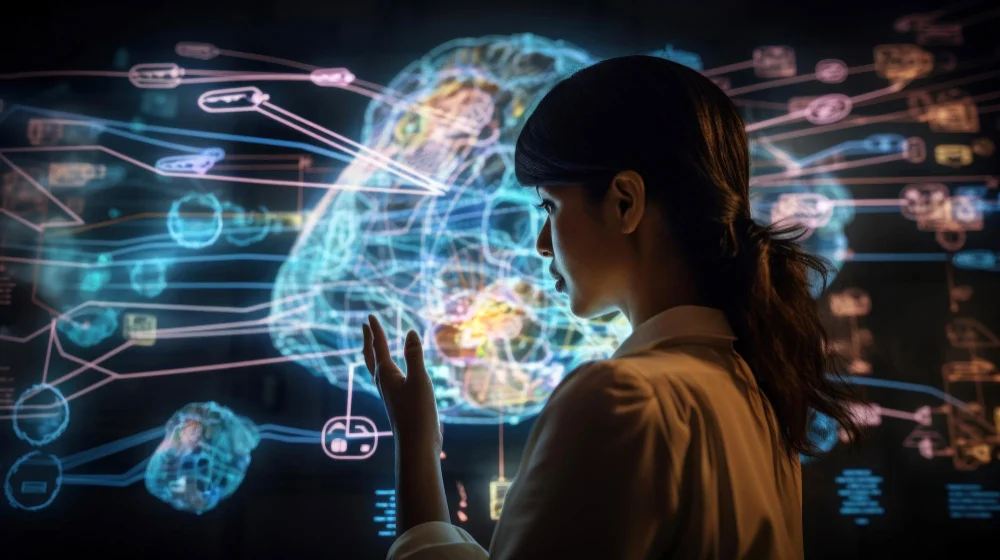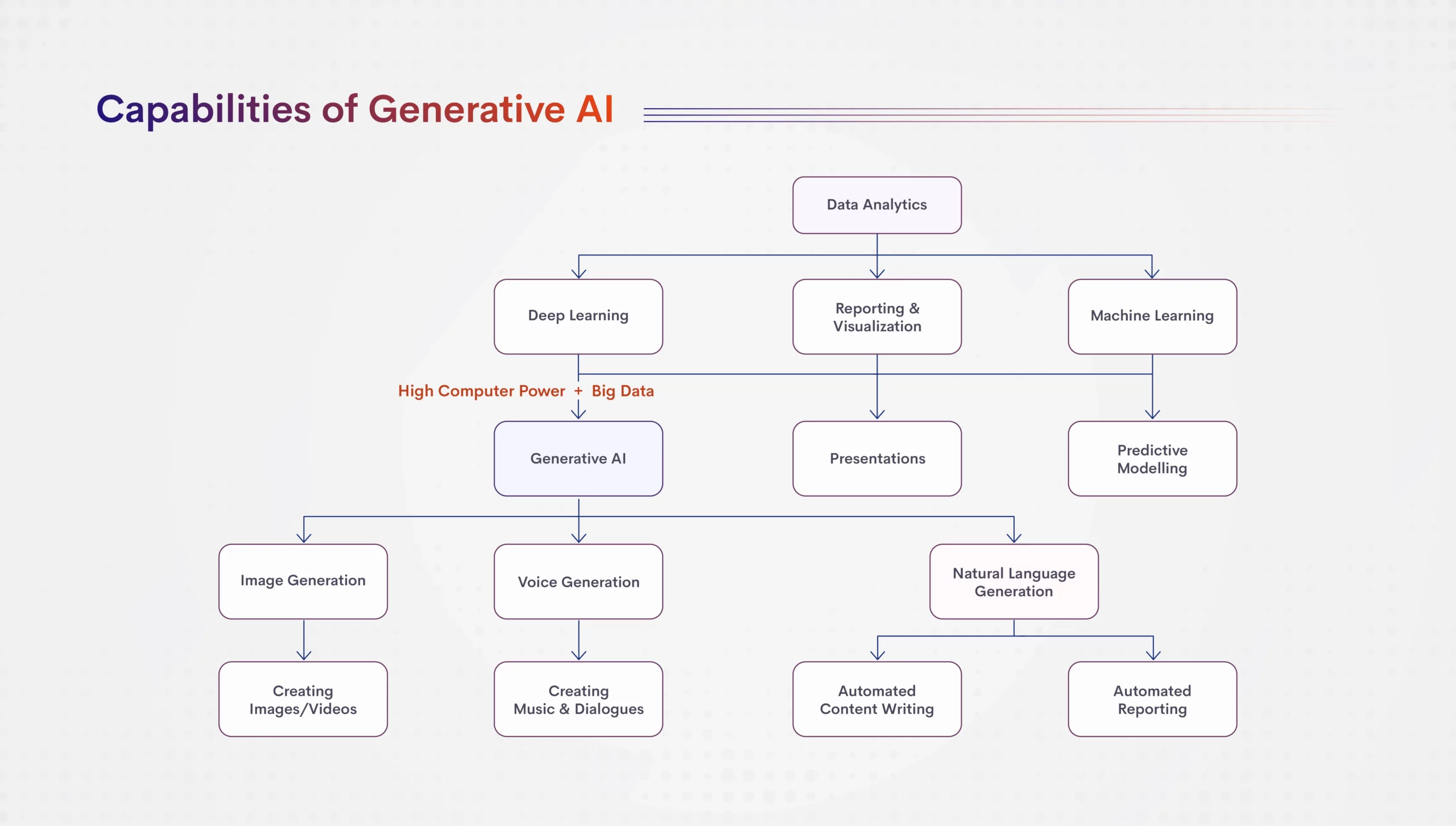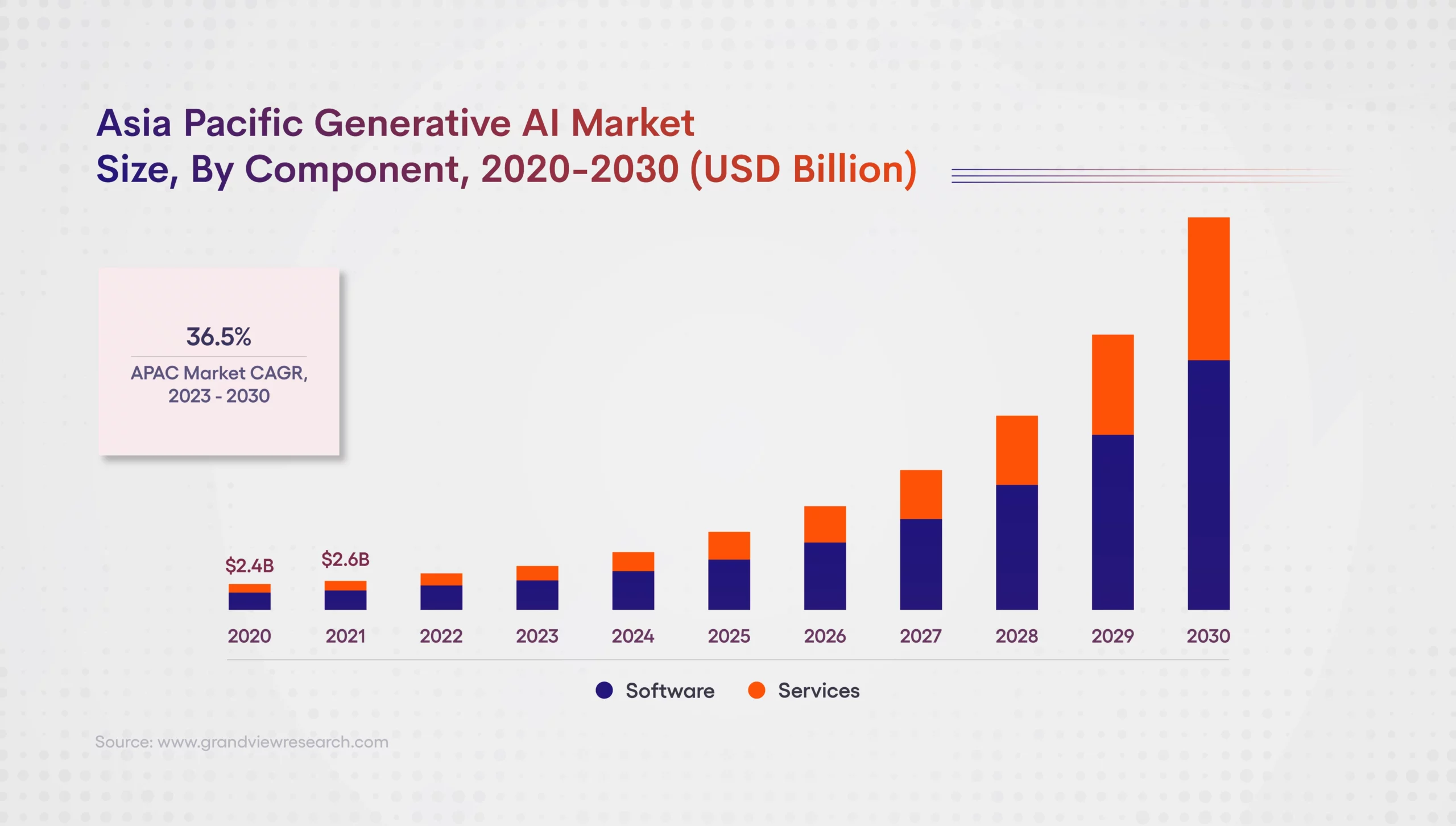- Blog
- August 7, 2023
Demystify the enigma of generative AI

- Blog
- August 7, 2023
Demystify the enigma of generative AI
The emergence of AI holds the same transformative significance as the invention of the microprocessor, personal computers, the Internet, and mobile phones. Its impact will revolutionize the way people work, learn, travel, receive healthcare, and communicate with one another. Entire industries will undergo reorientation to embrace their potential, and businesses will set themselves apart by utilization of AI technologies.
The buzz around generative tools like ChatGPT and Stable Diffusion has sparked conversations about the future of artificial intelligence (AI). As the excitement grows, people are curious about the next direction AI will take.
let’s delve into the world of Generative AI from an Analytics perspective and contemplate its future in the tech world.

The flow chart clearly illustrates that Generative AI is an innovative and cutting-edge element within the broader Analytics pipeline. It constitutes a significant portion of deep learning, which is currently driving revolutionary advancements in other stages of the pipeline. It’s important to acknowledge that deep learning, while an upgraded version of machine learning, heavily relies on substantial computational power and training to achieve its remarkable capabilities.
Future of Generative AI:

The global generative AI market demonstrated its value by reaching USD 10.14 billion in 2022. With a projected compound annual growth rate (CAGR) of 35.6% from 2023 to 2030, this dynamic industry is poised for significant expansion and innovation in the coming years.
Generative AI in the Metaverse:
Generative AI in the Metaverse brings dynamic virtual environments, personalized avatars, and lifelike NPCs. It fosters user-generated content, AI-driven quests, and seamless language translation. With adaptive learning, AI moderation, and virtual commerce, it enhances immersion and creativity in the interconnected digital universe.
Visual AI:
Visual AI and Generative AI continue to evolve and complement each other, we can expect a proliferation of creative applications, enhanced virtual experiences, and practical solutions to complex problems. However, the responsible and ethical use of these technologies remains essential to address potential challenges such as bias, and privacy concerns, and ensuring that AI-generated content aligns with societal values.
Medical imaging and diagnostics:
Generative AI in medical imaging and diagnostics holds promise for the future, offering enhanced image quality, faster diagnostics, and personalized treatment plans. It can assist in anomaly detection, data augmentation, and 3D image reconstruction, leading to improved patient care and earlier disease detection.
Synthetic data:
Generative AI empowers the creation of varied synthetic data, leading to enhanced generalization and robustness in AI models. By promoting data diversity, it safeguards user privacy without compromising the effectiveness of AI models. Additionally, it effectively simulates rare events, bolstering the capability of AI models to detect anomalies accurately. As a result, synthetic data enables AI models to be well-prepared for challenging edge cases.
A significant advantage of utilizing Generative AI for synthetic data is its potential to substantially reduce the necessity for costly data collection processes. This approach revolutionizes AI development by ushering in a future characterized by heightened versatility, accuracy, and adaptability across diverse industries.
Self-supervised learning:
It enables models to learn from unlabeled data and use synthetic data for efficient training. This approach enhances data efficiency, feature learning, and domain adaptation. Moreover, it fosters robustness to noise, enables explainable AI, and facilitates realistic simulations, propelling AI advancements to new heights.
Hyper-personalization:
Generative AI is revolutionizing the future of hyper-personalization. By harnessing this technology, businesses can offer individualized experiences like never before. From personalized content creation and tailored product recommendations to adaptive virtual assistants and customized learning experiences, Generative AI enables a new era of user-centric engagement and satisfaction. As technology advances, hyper-personalization will become more refined and impactful, shaping the way businesses interact with their customers and providing unparalleled levels of personalized services and products.
Ethical Use of Generative AI
Transparency and Disclosure:
Inform your audience when content is AI-generated. Whether it’s images, texts, or any other material, make it evident that it is artificially created. Avoid any misleading or deceptive practices that could confuse users about the origin of the content.
Respect Privacy and Consent:
Ensure that data used to train generative AI models respects user privacy and is acquired with proper consent. Obtain explicit permission from individuals before using their data. Handle sensitive information carefully and refrain from generating content that could harm or violate someone’s privacy.
Avoid Harm and Misinformation:
Refrain from using generative AI for harmful purposes, such as creating deep fake content that may damage someone’s reputation or spread false information. Take responsibility for the generated content, verifying its accuracy and appropriateness before dissemination.
Attribution and Copyright:
Respect copyright and intellectual property rights. If you use existing copyrighted content to train or enhance the generative AI, ensure you have the necessary permissions to do so. Provide proper attribution to the sources when utilizing datasets or models created by others.
Fairness and Bias:
Be conscious of biases in the training data that could lead to biased outputs from the generative AI. Regularly audit and assess your AI models for potential biases, and take measures to mitigate them.
Security and Safety:
Implement security measures to safeguard the AI model from unauthorized access or malicious use. Conduct thorough testing to ensure that the generated content does not pose safety risks or harm users.
Educational and Non-Malicious Use:
Promote the educational use of generative AI for creative purposes, research, and learning. Refrain from employing generative AI for malicious activities, such as spamming, phishing, or generating harmful content.
Monitor and Adapt:
Continuously monitor the output of your generative AI models to identify any inappropriate or harmful content. Be prepared to make necessary adjustments and updates to the model to improve its ethical behavior.
Collaborate and Share Best Practices:
Engage with other AI practitioners and researchers to exchange best practices for ethical AI development and usage. Stay informed about ethical guidelines and policies established by organizations, governments, and AI communities.
Wrapping-up:
Generative AI has sparked a wave of innovation and creativity, leading to a profound transformation across multiple industries. Its rapid progress signifies a paradigm shift, empowering AI to complement human capabilities and unlock new frontiers in the digital era.
With Generative AI at the forefront, we witness a remarkable fusion of human ingenuity and artificial intelligence, paving the way for unprecedented advancements in diverse fields. This convergence fuels the development of groundbreaking applications, revolutionizes content creation, enhances user experiences, and fosters innovations previously thought beyond reach. It has become an indispensable force, pushing the boundaries of what’s possible, and ushering in a future where human-AI collaboration drives progress and transforms industries in unimaginable ways.




